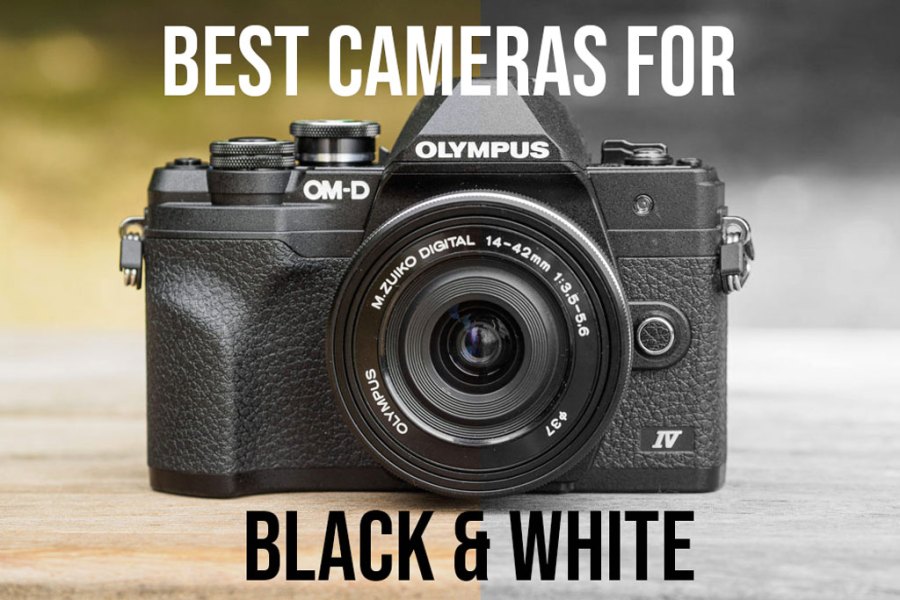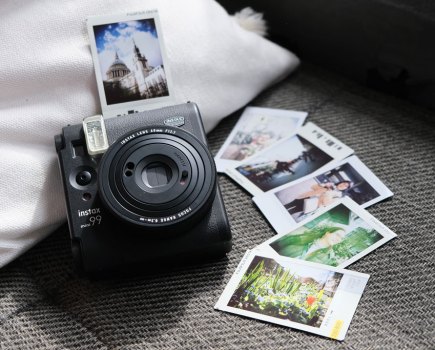Jon Stapley lists the best cameras for black and white photography. Here’s the kit you need for unforgettable, dramatic monochrome images.
Monochrome photography is a unique discipline, full of its own special challenges and rewards. For those committed to shooting in this style, it makes sense to select a camera suited to it. The priorities for selecting one for black and white photography are different from those for shooting in colour.
Manufacturers are well aware of the popularity of monochrome, and have adapted their cameras accordingly with dedicated black and white modes. Indeed, some have gone the whole hog and brought out cameras that only shoot in black and white. All in all, there are lots to choose from.
This guide will help you navigate the world of black and white cameras and find one that’s right for you. Note that we’re only dealing with digital models here. For shooting black and white analogue images, check out our best film guides. To learn how to shoot great black and white images, read Will Cheung’s complete guide to black and white photography that explains everything you need to know about capturing the world in monochrome.
All the cameras on this list are perfect for creating striking, dramatic black and white images, whether you capture them in-camera or want to convert the images later in software.

How to choose the best cameras for black and white
So what are the priorities for picking a camera that’s going to capture fantastic black and white images? Dynamic range is of huge importance – this defines the difference between the darkest and lightest tones in an image, and is crucial for creating monochrome images with depth and tonality. Cameras with larger sensors offer greater dynamic range. However, these are also bigger and more expensive (see our guide to camera sensor sizes for more on this). Sharpness is just as important in monochrome as it is in colour, so you may also want to pick a camera with a fast, accurate autofocus system.
A ‘true’ monochrome camera
Then there are “true” monochrome cameras – that only shoot black and white. These deliver the best raw monochrome image quality, but tend to be very expensive. Using a regular colour camera is the more accessible route for most people, and many manufacturers pack their models with fantastic in-camera monochrome modes; particularly Fujifilm. The third option is to have a colour camera converted to shoot black and white images by a specialist – this is especially good if you shoot infrared photography. Check out infraredcameraconversions.co.uk to learn more.
Read on for the best deals on black and white cameras, where you’ll also find some of the best monochrome camera deals, as our ‘Buy now’ buttons are set up to automatically take you to the best prices from trusted retailers. You’ll also find a list of other retailers below each camera, so you can find the right deal for you.
- Best camera for black and white overall: Leica Q2 Monochrom – Buy now
- Best beginner camera for black and white photography: Fujifilm X-T30 II – Buy now
- Best enthusiast camera for black and white photography: Pentax K-3 Mark III Monochrome – Buy now
- Best black and white rangefinder camera: Leica M11 Monochrom – Buy now
- Best black and white camera for travel: Panasonic Lumix GX9 – Buy now
- Best cheap black and white camera: Olympus OM-D E-M10 Mark IV – Buy now
- Best medium-format black and white camera: Fujifilm GFX50S II – Buy now
- Best black and white camera for street photography: Ricoh GR III – Buy now / GR IIIx – Buy now
- Best second-hand black and white camera: Leica M Monochrom (Typ 246) – Buy now
- Best black and white camera with a viewfinder: Fujifilm X-Pro3 – Buy now
- Best weatherproof black and white camera: Panasonic Lumix S5 – Buy now
Why you can trust Amateur Photographer
We spend many hours testing every product we recommend, in detail, in a variety of situations and shooting scenarios, and only use experts for our reviews, so you can be sure that you’re getting the best products. Find out more about our expert writers.
Best overall
Best camera for black and white overall: Leica Q2 Monochrom

Amateur Photographer verdict
As a dedicated black and white camera with a monochrome sensor, this model is worth considering. With intuitive physical controls and jaw dropping image quality the Q2 is a real pleasure to shoot with- Sublime handling experience
- Stellar image quality
- High resolution
- Absurdly expensive
- 28mm is quite wide
Specifications at a glance:
| Camera type | Compact |
| Sensor | 47.3MP full-frame monochrome sensor; 28mm f/1.7 lens |
| Continuous shooting | Up to 20 fps burst shooting with electronic shutter; 10fps mechanical |
| ISO | ISO 100 – 100,000 |
| Focus points | 225 autofocus points |
While it is easier than ever to convert an image to black and white post-capture, a dedicated black and white camera with a monochrome sensor delivers genuine advantages. You get more detail, better dynamic range, lower noise and high ISOs. If you know you’re going to shoot in black and white exclusively, this model is well worth considering.
The Leica Q2 Monochrom is the best black and white camera money can buy. Sleek in looks and superb in handling, it’s one of the most immersive shooting experiences out there. The autofocus is excellent, though as we mentioned in our review, many enthusiasts will likely prefer to use the superb manual focusing experience that employs the focus ring and a precise focus-peaking system.
With a 47.3MP full-frame sensor and a stabilised 28mm f/1.7 lens, the Leica Q2 Monochrom delivers fantastic monochrome images. It’s ridiculously expensive, obviously, but if you can justify the outlay, it’s a camera like no other.
Read why we gave the Leica Q2 Monochrom five stars
Best beginner camera for black and white photography: Fujifilm X-T30 II

Amateur Photographer verdict
The X-T30 Mark II is among the best-value mirrorless cameras out there. The film simulation modes on this camera will be of particular interest to black and white photographers.- B&W film simulation modes
- Lots of physical controls
- Some badly placed buttons
- No in-body stabilisation
Specifications at a glance:
| Camera type | Mirrorless |
| Sensor | 26.1MP X-Trans CMOS IV APS-C |
| Continuous shooting | Up to 30 fps burst shooting with electronic shutter (cropped), 20 fps uncropped |
| ISO | ISO 80 – 51,200 (extended) |
| Focus points | 425 autofocus points |
The X-T30 II is an updated version of one of Fujifilm’s popular cameras in its mirrorless X series, the Fujifilm X-T30. It’s one of the best-value mirrorless cameras out there, and we highly praised it in our review. The film simulation modes on this camera will be of particular interest to black and white photographers. These fine creations do exactly what they sound like, and allow you to emulate classic film stocks.
The Acros mode simulates the classic fine-grain film, delivering ultra-sharp images full of detail. Both this and the classic Monochrome mode can be used with red, green or yellow filters for different effects. The tactile, dial-based handling experience of the X-T30 II also feels like a throwback to film cameras of yesteryear.
Read our full review of the Fujifilm X-T30 II
Best enthusiast camera for black and white photography: Pentax K-3 Mark III Monochrome
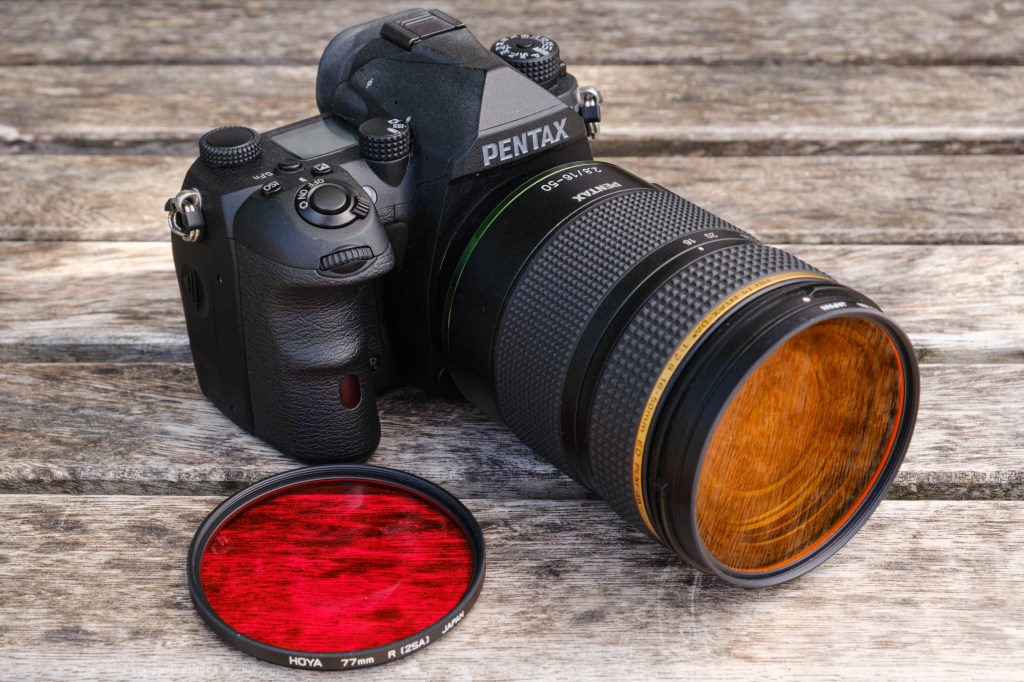
Amateur Photographer verdict
This is another camera with a dedicated monochrome sensor, making it a great option for black and white photography, it creates lovely monochrome image files with low noise & huge dynamic range- Robust, enthusiast-friendly design
- High pixel-level sharpness and low noise
- Excellent dynamic range
- Fairly chunky
- Shooting experience isn’t special
- IBIS isn’t as effective with telephoto lenses
- Highlights clip a stop earlier at ISO 200 than at ISO 400 in both JPEG and raw files
Specifications at a glance:
| Camera type | DSLR |
| Sensor | 25.7MP APS-C |
| Continuous shooting | Up to 12 fps continuous shooting |
| ISO | ISO 200 – 1,600,000 |
| Focus points | 101 autofocus points |
In most respects, the Pentax K-3 Mark III Monochrome is identical to its parent camera the Pentax K-3 Mark 3. However, with the colour filter array removed, more light is able to reach the sensor. This results in the only obvious change of specification, with the lowest available sensitivity increasing from ISO 100 to ISO 200.
A close look at the menus and settings reveals that, unsurprisingly, everything relating to white balance or colour output has also been removed. Externally, all the buttons and dials are now marked in grey, rather than white, while the onscreen user interface is almost entirely monochrome. But that’s about the full extent of the differences.
Five-axis in-body image stabilisation (IBIS) is built in and works with almost any lens you can use, promising up to 5.5 stops shake reduction. The D-LI90 battery promises an impressive 800 shots per charge, and it’s capable of recording 4K video, complete with built-in microphone and headphone sockets.
It’s great to see a company other than Leica proving the advantages of the monochrome sensor.
Read the full review of the Pentax K-3 Mark III Monochrome
Best black and white rangefinder camera: Leica M11 Monochrom
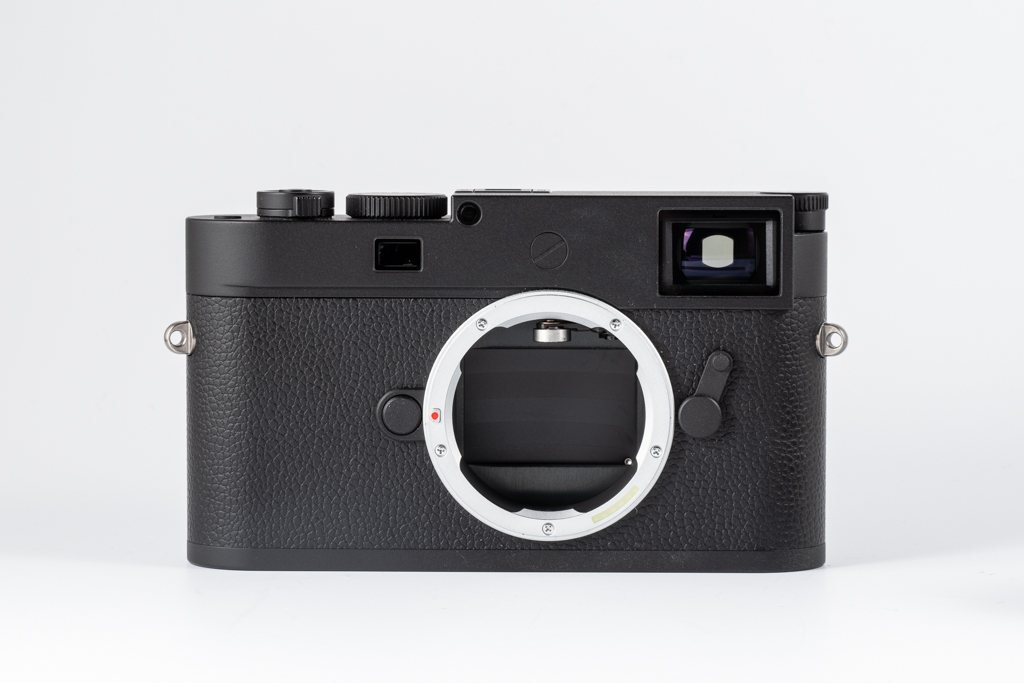
Amateur Photographer verdict
For black and white photographers looking for the experience of shooting with a manual focusing rangefinder camera, the Leica M11 Monochrom is your dream machine – but you’ll need deep pockets.- Large viewfinder and first-class rangefinder
- Superlative image quality
- Gives a great user experience
- Ludicrously expensive
- Touchscreen could be better integrated
Specifications at a glance:
| Camera type | Digital rangefinder |
| Sensor | 60.4MP monochrome full-frame |
| Continuous shooting | 4.5 fps burst shooting |
| ISO | ISO 125 – 200,000 |
| Focus | Manual rangefinder focusing |
For those really committed to black and white and the experience of shooting with a manual focusing rangefinder camera, the Leica M11 Monochrom is your dream machine – but you’ll need deep pockets. It’s $9,195 / £8,300 (body only) and Leica M optics aren’t cheap either – the Summilux-M 50mm f/1.4 ASPH is $4,495 / £4,000. As we said in our review, the experience of using this camera is incredible – that rich, high-resolution sensor captures the finest details, and while the experience of rangefinder focusing is tricky to master, it’s immensely satisfying once you get it down.
With tremendous high-ISO performance, impressive dynamic range and exquisite handling, the M11 Monochrom is hugely capable and extremely desirable. However, as this is a Leica, ownership comes at a very significant cost.
Read our review of the Leica M11 Monochrom
Best black and white camera for travel: Panasonic Lumix GX9

Amateur Photographer verdict
The Panasonic Lumix GX9 is a wonderful take-everywhere camera for black and white street photography.- Lightweight and portable
- Arty monochrome modes
- Large lens selection
- AF tracking hit-and-miss
- Controls awkward when using viewfinder
Specifications at a glance:
| Camera type | Mirrorless |
| Sensor | 20.3MP Micro Four Thirds |
| Continuous shooting | 9 fps burst shooting |
| ISO | ISO 100 – 25,600 (extended) |
| Focus points | 49 autofocus points |
One of the most enduringly popular cameras in the Lumix G mirrorless range, the Panasonic Lumix GX9 is a wonderful take-everywhere camera. Now discontinued, it’s widely available on the used market. It’s got an impressive tilting 1240k-dot LCD screen that makes it easy to shoot from all sorts of different angles, and its autofocus system is snappy and accurate – though it can sometimes struggle with moving subjects.
In our review, we rated the Panasonic Lumix GX9 highly as a street photography camera. One of the things we praised was its attractive L Monochrome mode. This feature is designed to emulate the look of black and white film, with even the option to add a grain effect. Also available is L. Monochrome D, which can be used to bring out additional detail in the darker areas of the frame.
Best cheap black and white camera: Olympus OM-D E-M10 Mark IV

Amateur Photographer verdict
The Olympus OM-D E-M10 Mark IV is an easy to handle entry level camera that’s also an affordable option for black and white photographers.- Small and portable
- Affordable price tag
- Excellent monochrome JPEG quality
- Smaller sensor affects dynamic range
- Aging autofocus system
Specifications at a glance:
| Camera type | Mirrorless |
| Sensor | 20MP Micro Four Thirds |
| Continuous shooting | 15fps continuous shooting |
| ISO | ISO 80 – 25,600 (extended) |
| Focus points | 121 autofocus points |
For an affordable route into monochrome photography, we’d definitely recommend the Olympus OM-D E-M10 Mark IV. It’s a Micro Four Thirds camera, meaning there are loads of lenses to choose from, just as with the Lumix GX9 above. Despite its small size and relatively beginner-friendly price, the E-M10 Mark IV packs in plenty of features that see it punching above its weight, such as highly effective 5-axis stabilisation, Live Composite mode for long exposures, and more.
Monochrome-wise, the E-M10 Mark IV offers in-camera Monochrome picture modes, with the option to add colour tints as though you were using a physical filter. For images with a bit more pop, you can also use Olympus’s digital Art Filter modes in monochrome. Give images a bit more punch with the Dramatic Tone Art Filter, or add a bit of grain for a film effect – it’s all there to play with.
Read our Olympus OM-D E-M10 Mark IV review.
Best medium-format black and white camera: Fujifilm GFX50S II

Amateur Photographer verdict
The stunning tonality and dynamic range offered by the Fujifilm GFX 50S II’s larger medium format sensor is ideal for creating striking monochrome images.- Gorgeous image quality
- Superb monochrome modes
- Highly effective stabilisation
- Cheaper than most medium format cameras…
- …though still expensive
- Slower than other cameras
Specifications at a glance:
| Camera type | Medium format mirrorless |
| Sensor | 51.4MP medium format |
| Continuous shooting | 3fps continuous shooting |
| ISO | ISO 50 – 102,400 (extended) |
| Focus points | 117 or 425 autofocus points |
For monochrome photographers, digital medium format can be a great medium to explore. The stunning tonality and dynamic range offered by the larger sensor is ideal for creating rich, striking monochrome images. Also, the famous Film Simulation modes offered by Fujifilm are present and correct on the GFX 50S II. Once again, these include the simulation of Acros, one of Fujifilm’s most popular b&w stocks, and a more general Monochrome mode, with options for yellow, red, or green filters.
Medium format is expensive. Always has been. But the Fujifilm GFX 50S II is one of the most affordable routes into medium format, with a sub-£4,000 price that undercuts pretty much all of the competition. We couldn’t help but give it the full five stars in our review, as the image quality you get for the price is simply sublime. It’s also nowhere near as bulky and unwieldy as other medium-format systems. Granted, you’re not going to get the kind of speed in autofocus and shooting as you get with smaller-sensor system cameras, but then, that’s not the reason anyone buys medium format.
Read our Fujifilm GFX50S II review.
Best black and white camera for street photography: Ricoh GR III / GR IIIx
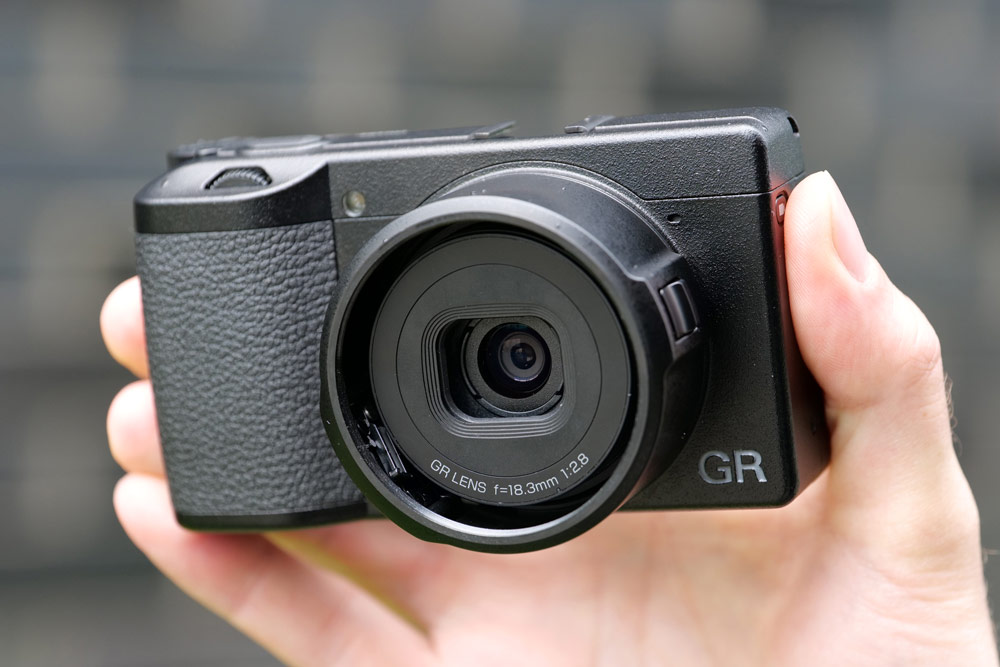
Amateur Photographer verdict
The Ricoh GR III is designed for street shooting, for taking everywhere with you, and for capturing instantaneous moments – and it’s ideal for dramatic, black and white photos.- Excellent touchscreen experience
- Travel-friendly setup
- 40mm option available
- No viewfinder option
- Poor AF in low light
For the GR lllX:
Specifications at a glance:
| Camera type | Compact |
| Sensor | 24.2MP APS-C sensor; 18.3mm f/2.8 (28mm equivalent) lens |
| Continuous shooting | 4 fps burst shooting |
| ISO | ISO 100 – 102,400 |
| Focus points | Hybrid autofocus system |
The Ricoh GR III is a photographer’s camera. It’s designed for street shooting, for taking everywhere with you, and for capturing instantaneous moments – and as such, it’s ideal for dramatic, black-and-white imagery. It has excellent dynamic range, which also helps for monochrome shooting, and its fixed 28mm equivalent f/2.8 lens is versatile in a host of situations.
One thing to be aware of is that the GR III has no viewfinder, and also no means of attaching one. You have to be comfortable composing with the rear screen. Also, as we mentioned in our review, its autofocus can sometimes hunt in low light.
If 28mm is too wide for you, then consider also the Ricoh GR IIIx. It’s essentially an identical camera that has a 40mm equivalent lens. You can read our full, in-depth review below to learn more about it.
Our review of the Ricoh GR III
Our review of the Ricoh GR IIIx
Best second-hand black and white camera: Leica M Monochrom (Typ 246)
Amateur Photographer verdict
With a dedicated monochrome sensor, this Leica rangefinder is perfect for black and white photography. Having the Leica M mount also gives you access to some of the best lenses money can buy.- Exceptional dynamic range
- Price has come down since launch
- Still very pricey
- Rangefinder focusing takes practice
Specifications at a glance:
| Camera type | Digital rangefinder |
| Sensor | 24MP monochrome full-frame |
| Continuous shooting | 4 fps burst shooting |
| ISO | ISO 320 – 100,000 |
| Focus points | Rangefinder focusing |
We first published our Leica M Monochrom (Typ 246) review back in 2015. At that time, it was retailing for £5,750 body-only, but these days on the second-hand market, we’ve seen it going in the range of $3400-3550 / £2,599-2,879. While that’s still a chunk of change, it’s also a hell of a saving on a frankly exceptional camera.
With a dedicated monochrome sensor, this Leica rangefinder is optimised for black-and-white imaging, delivering exceptional dynamic range and quality. Having the Leica M mount also gives you access to some of the finest lenses money can buy.
Best black and white camera with a viewfinder: Fujifilm X-Pro3

Amateur Photographer verdict
The X-Pro3 has excellent B&W modes and provides a rangefinder-style experience without the expense or difficulty of a rangefinder camera.- Immersive, rangefinder-style experience
- Excellent B&W modes
- “Invisible” screen won’t be for everyone
- Cheap Fuji X options available
Specifications at a glance:
| Camera type | Mirrorless |
| Sensor | 26.1MP X-Trans CMOS IV APS-C |
| Continuous shooting | Up to 30 fps burst shooting with electronic shutter (cropped), 20 fps uncropped |
| ISO | ISO 80 – 51,200 (extended) |
| Focus points | 425 autofocus points |
It takes a lot for a camera to surprise us nowadays, so our attention was immediately caught by Fujifilm’s bold X-Pro3. Its reversed, “fold-down” rear screen isn’t visible during normal shooting, encouraging the user to immerse themselves in the viewfinder experience, without the constant “chimping” at the rear screen that can plague digital photography. It essentially provides a rangefinder-style experience without the expense or difficulty of a rangefinder camera.
Does it work? That’s up to you. We loved it in our Fujifilm X-Pro3 review, but also acknowledged it won’t be for everyone. There are cheaper cameras in the Fuji stable with similar or identical imaging setups and without the handling quirks. However, the retro experience of using an X-Pro3 feels so perfectly right for black and white shooting that we simply had to include it here. The X-Pro3 was discontinued in 2023, so you’ll have to search around for it as it is getting increasingly hard to find, and expect to pay in the region of $1,700 / £1,100-1,400 (body only) for a good sample.
Read our full review of the Fujifilm X-Pro3.
Best weatherproof black and white camera: Panasonic Lumix S5
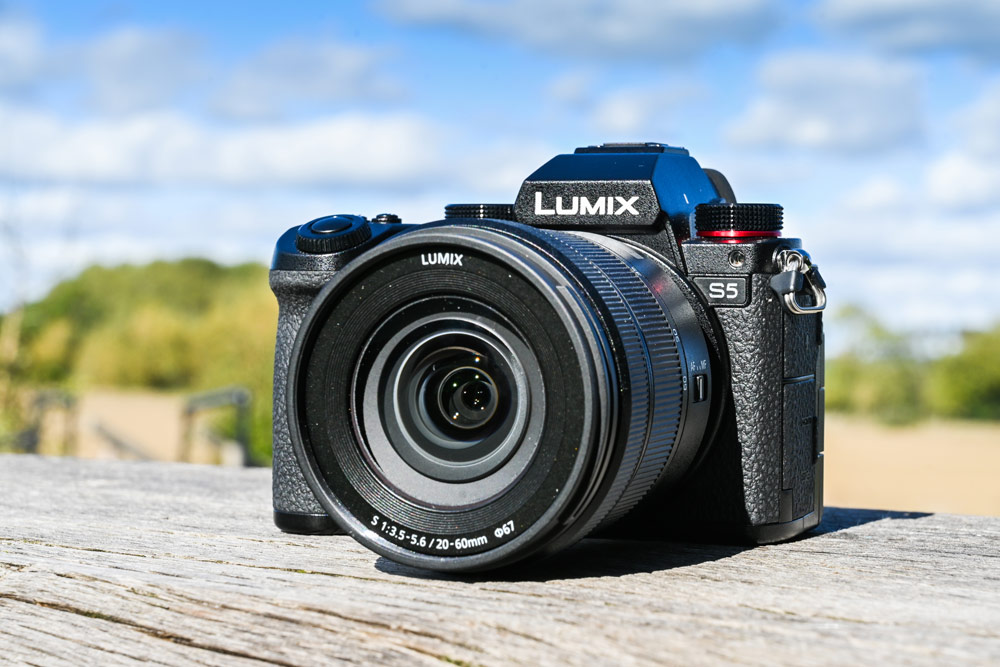
Amateur Photographer verdict
The Lumix S5 is Panasonic’s smallest full-frame mirrorless camera, and it is also optimised for black and white shooting. The splash and dust resistant body will appeal to landscape shooters- Full-frame in a light body
- Splash/dust resistant
- Sluggish burst mode
- Rivals have better AF
Specifications at a glance:
| Camera type | Mirrorless |
| Sensor | 24.2MP full-frame |
| Continuous shooting | 7 fps continuous shooting |
| ISO | ISO 50 – 204,800 (extended) |
| Focus points | 225 autofocus points |
Just like the Lumix GX9, the Panasonic Lumix S5 has the L.MONOCHROME designed specifically to optimise black and white shooting – only now, they’re paired up with a full-frame sensor. The Lumix S5 is capable of capturing images with the kind of hugely impressive dynamic range that’s perfect for black and white photography. It does so in a body that’s both lightweight and weatherproof.
As we mentioned in our full review, the lightness of the Lumix S5 addresses some of the criticisms users had of previous Lumix S cameras. We also had a lot of time for the 20-60mm kit lens you can buy it with, which is an excellent all-purpose optic.
Panasonic has since released an upgrade to this camera, the Panasonic Lumix S5 II, which fixes the sluggish autofocus and adds a raft of video updates. We’re sticking with the more affordable original as our pick for now, but the Mark II version is worth consideration if you have a higher budget and prioritise fast focusing.
Read our full review of the Panasonic Lumix S5
Written by Jon Stapley with additional information by Joshua Waller & Michael Topham
Are you looking to improve your black and white photography? Read more on monochrome with these articles:
- How to shoot stunning black and white portraits
- How to convert images to black and white in Adobe Lightroom
- Black and white street photography: Tips and techniques from the experts
- Mono magic: Black and white landscape photography

